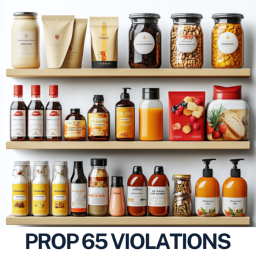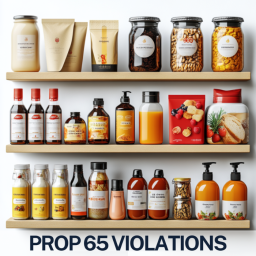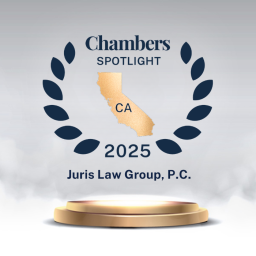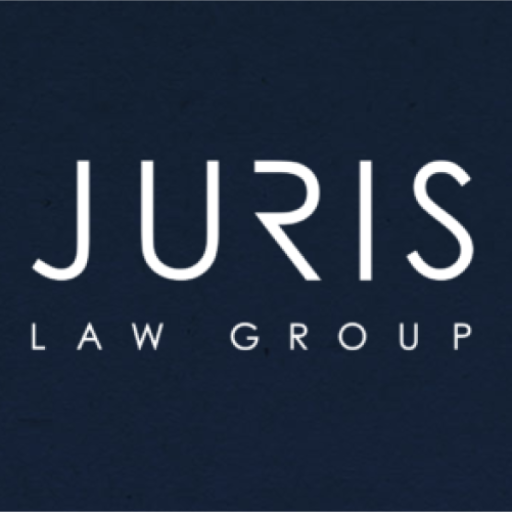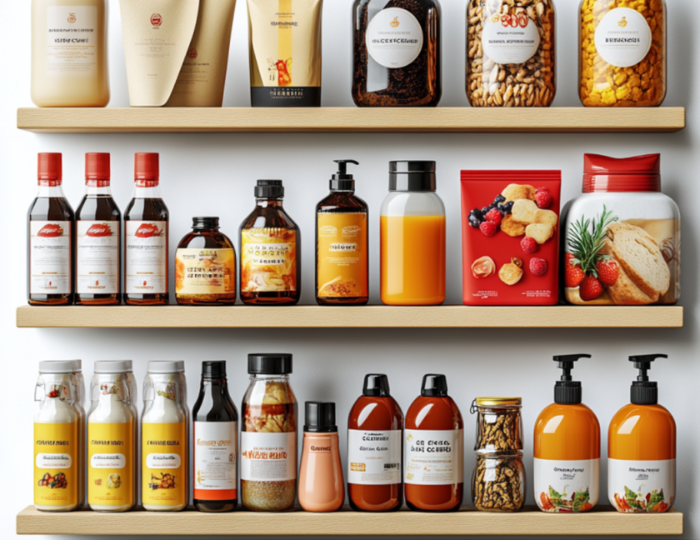
California’s Proposition 65 is more than just a compliance concern—it poses ongoing reputational and financial risks for food, beverage, supplement, and cosmetic brands. From January through April 30, 2025, more than 1385 Notices of Violation (NOVs) were issued targeting well-known ingredients, packaging materials, and brand categories. This article breaks down publicly filed data to expose enforcement patterns, chemicals most often cited, and product categories that have been repeatedly targeted. If you manufacture, distribute, or sell products in California, this guide will help you understand the threat and how to proactively mitigate it.
| January 1 to April 30, 2025 Proposition 65 Notice of Violation Summary | ||
| Number of Violations (each violation can include many targeted companies) | Listed Chemicals | Types of Products Targeted |
| 546 | Heavy metals (lead, cadmium, arsenic) | Seafood (sardines, tuna, squid, octopus, seaweed); ceramics/mugs/glassware/ candleholders/; pasta; protein/greens powders; cinnamon supplements; pasta; veggie chips/sticks; granola/oat bars; seeds; protein bars; dried fruit; dried veggies; kale chips; brass components; fishing tackle; adapters/fittings |
| 213 | Phthalates (DEHP, DINP, DBP) | Shoes; tools, pouches/bags/purses; cases; rope lights; sweatpants, hoodie; banners; safety vests; vinyl covers; tapes; tablecloths; jackets; gloves; |
| 105 | Diethanolamine, cocamide DEA | Mascara, gels, lotions, cleanser, shampoo, shave gels/creams, foundation |
| 82 | PFOA, PFNA, PFOS | Shower caps; umbrellas; shower curtains/liners; clams/anchovies; kid’s jackets; tapes; laptop cases; chair covers |
| 17 | BPA | Kidney beans, tuna, pineapple slices, mushrooms, coconut water/milk (can/carton) |
| 10 | Chromium (hexavalent compounds) | Gloves, belts, footwear |
| 7 | Toluene | Furniture wax |
| 7 | delta-9-tetrahydro-cannabinol, Marijuana smoke | Cannabis products, gummies |
| 5 | Nitrous oxide | Foam creamers; whipped topping |
| 4 | Naphthalene/p-Dichlorobenzene | Moth balls |
| 2 (dozens of retailers/restaurants) | BPS | Thermal receipt paper |
What Is Prop 65 and Why Does It Matter to Food, Beverage, Supplement, and Cosmetic Brands?
Formally called the Safe Drinking Water and Toxic Enforcement Act of 1986, Proposition 65 mandates that businesses must warn Californians about significant exposures to chemicals that cause cancer, birth defects, or other reproductive harm. The list currently includes over 900 chemicals, including lead, acrylamide, cadmium, phthalates, and PFAS.
While intended to protect public health, Prop 65 has created an active plaintiffs’ bar. Consumer advocacy groups and law firms issue hundreds of 60-day notices each month, often focusing on trace contaminants naturally present in foods or resulting from packaging.
Violations carry serious consequences:
- Civil penalties of up to $2,500 per day per violation
- Costly legal fees and settlements
- Mandatory warning labels, product reformulation, or market withdrawal
What Are the Most Common Chemicals Cited in Prop 65 Enforcement in 2025?
| Chemical | Notices of Violation |
| Lead and lead compounds | 314 |
| Cadmium | 92 |
| Acrylamide | 87 |
| Arsenic | 48 |
| DEHP (Phthalate) | 36 |
| DINP (Phthalate) | 33 |
Notable Chemical Trends in 2025
- PFAS in the Spotlight: PFOS, PFOA, and PFNA are now among the most frequently cited chemicals, found in food packaging, textiles, and cookware. Their enforcement is especially aggressive due to the lack of established safe harbor levels.
- Heavy Metals in Foods: Agricultural commodities like cacao, turmeric, and spinach frequently test positive for lead and cadmium, which carry over into processed products.
- Cosmetics Still Under Scrutiny: Diethanolamine remains a frequent target, while enforcement against titanium dioxide has declined, likely due to earlier saturation.
- BPA in Food Packaging: Even trace detections of BPA in cans, linings, and seals can result in NOVs due to the lack of an oral MADL.
- Mothballs Resurface: Surprisingly, mothball products were cited for naphthalene and p-dichlorobenzene, indicating a return to older product categories.
- Decline in Phthalate Cases: Though still common, phthalate-related notices have decreased since late 2024.
- Thermal Receipt Paper and BPS: BPS, a BPA substitute, is under fire in NOVs against retailers and restaurant groups. No safe harbor level has been derived.
What Types of Products Are Being Targeted Most Frequently?
Food and Beverage Products
- Spices & Seasonings (curry, mole, blends)
- Confectionery (chocolate, gummies, bars)
- Snacks & Baked Goods (chips, crackers, granola)
- Dried Fruits & Nuts (mango, sunflower seeds, raisins)
- Seafood (mussels, anchovies, shrimp, tuna)
- Beverages (coffee, kombucha, coconut water)
- Processed Grains (rice pasta, fusilli)
Supplements
- Protein Powders (pea, rice, whey blends)
- Herbal Capsules (turmeric, ginger, cinnamon)
- Digestive & Nutritional Powders
Cosmetics
- Hair Gels, Growth Oils, Shampoos
- Lotions, Deodorants, Creams
- Skin Patches, Body Tapes
Household Products
- Shower Liners, Tablecloths, Tools
- Plastic Packaging, Cosmetics Cases
- Toys, Clothing, Footwear
- Mothballs, Waxes, Furniture Products

Who’s Being Targeted? The Top 10 Most Cited Companies in 2025
| Company | Notices Received |
| Amazon.com, Inc. | 30 |
| Ross Stores, Inc. | 11 |
| Trader Joe’s Company | 10 |
| Walmart, Inc. | 7 |
| Amazon.com Services LLC | 6 |
| The TJX Companies, Inc. | 5 |
| World Market, LLC | 5 |
| Goya Foods of California | 5 |
| Aldi Inc. | 5 |
| Walgreens Boots Alliance | 3 |

What Risks Do Licensors Face When Licensees Trigger Prop 65 Violations?
When brand owners license their trademarks or intellectual property, they may still face Prop 65 exposure if their name appears on the product packaging—even if they didn’t manufacture or distribute the product. Licensors like Amazon, TJX Companies, and Five Below have already been named in 2025 NOVs.
Best practices for licensors include:
- Requiring Prop 65 compliance warranties in all license agreements
- Mandating third-party testing by licensees
- Including indemnity and insurance obligations
- Monitoring licensee product listings and California sales
How Can My Company Avoid a Prop 65 Lawsuit?
1. Perform Ingredient and Packaging Testing
Use third-party labs to screen your finished goods and raw materials for heavy metals (lead, cadmium, arsenic), acrylamide, and phthalates. Repeat tests after sourcing or formulation changes.
2. Evaluate and Update Warning Labels
If exposure exceeds safe harbor levels, a Prop 65 warning is mandatory. Make sure your labels:
- Follow safe harbor language requirements
- Appear prominently on packaging and online
- Are specific to the chemical risk involved
3. Strengthen Your Supplier Agreements
Add clear indemnification provisions and chemical compliance warranties to every vendor contract. Make suppliers financially responsible for ingredients or materials that trigger NOVs.
4. Monitor New Notices and Competitor Risk
Regularly review Prop 65 filings from the California Attorney General. If brands in your category are being targeted, take preventive action.
5. Engage Experienced Legal Counsel
If you receive a 60-day notice, contact your attorney immediately. At Juris Law Group, we:
- Analyze claims
- Coordinate product testing
- Negotiate settlements
- Defend enforcement actions in court
Juris Law Group: California’s Trusted Counsel for Prop 65 Defense and Compliance
Juris Law Group is recognized for its experience in food, beverage, supplement, and cosmetic law. As general counsel to billion-dollar manufacturers and national CPG brands, we offer:
- Proactive Prop 65 compliance programs
- Custom warning label and risk mitigation strategies
- Supply chain reviews with indemnity protections
- Fast and effective resolution of Prop 65 enforcement actions
Why Clients Choose Us:
- Ranked in Chambers USA
- Track record of defending major retailers and manufacturers
- Insider knowledge of common plaintiff tactics and litigation trends
Frequently Asked Questions (FAQ)
Question: Is Prop 65 compliance optional if I sell online?
Answer: No. If your product ships to California, compliance is mandatory.
Question: What if I’m using natural ingredients?
Answer: Prop 65 applies even to naturally occurring metals like lead in cacao, turmeric, and spinach.
Question: What happens if I ignore a 60-day notice?
Answer: The plaintiff can file suit, and you may face statutory penalties, injunctions, and attorney’s fees.
Question: Can I fix a product after receiving a notice?
Answer: Possibly—but late compliance does not eliminate prior liability. You need legal strategy.

Proposition 65 Q&A for Businesses and Manufacturers
Question 1: What are my responsibilities under Proposition 65 as a manufacturer or distributor?
If you manufacture, produce, assemble, process, handle, distribute, store, sell, or otherwise transfer consumer products that expose individuals in California to listed chemicals, you are required to provide a “clear and reasonable” warning unless the exposure is below established safe harbor levels.
Question 2: Are small businesses exempt from Proposition 65 requirements?
Yes. Businesses with fewer than 10 employees, government agencies, and public water systems are exempt from the warning requirements and discharge prohibitions of Proposition 65.
Question 3: How can I determine if a warning is necessary for my product?
Review the Proposition 65 list of chemicals and assess whether your product or operations expose individuals to any listed chemicals. If exposure exceeds the safe harbor levels, a warning is required. If no safe harbor level exists, you must provide a warning unless you can demonstrate that the exposure poses no significant risk.
Question 4: What are safe harbor levels, and how do they affect my obligations?
Safe harbor levels are exposure thresholds established by OEHHA for listed chemicals. If your product exposes individuals to a chemical at or below its safe harbor level, you are exempt from the warning requirement. If no safe harbor level is established, you must either provide a warning or conduct a risk assessment to determine if the exposure level requires a warning.
Question 5: How should warnings be provided to consumers?
Warnings can be provided through various methods, including labeling the consumer product, posting signs at the workplace, distributing notices at a rental housing complex, or publishing notices in a newspaper. The warning must be clear and reasonable, effectively communicating the risk to consumers.
Question 6: What are the penalties for non-compliance with Proposition 65?
Businesses found in violation of Proposition 65 may face civil penalties of up to $2,500 per day for each violation. Additionally, courts may order businesses to stop the violating activity and may impose other remedies.
Question 7: If I manufacture components sold to other companies, am I responsible for warnings?
If you manufacture component parts or ingredients that contain listed chemicals and are sold to other manufacturers, you are responsible for providing warnings if you have knowledge that the end use of your component will result in exposure to a listed chemical.
Question 8: How can I stay updated on Proposition 65 requirements and chemical listings?
Regularly consult the OEHHA website for updates on the Proposition 65 list of chemicals, safe harbor levels, and regulatory changes. Staying informed will help ensure ongoing compliance with the law.
Want to Protect Your Brand from a Prop 65 Lawsuit?
To speak with a regulatory attorney or schedule a compliance audit, contact us today: [email protected]
